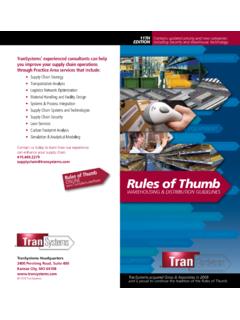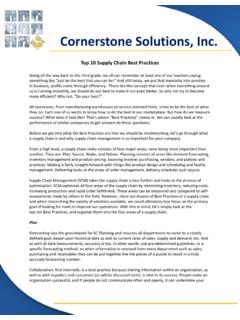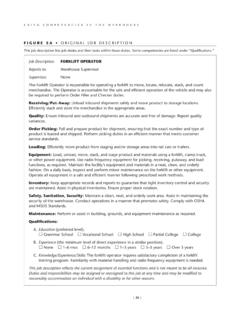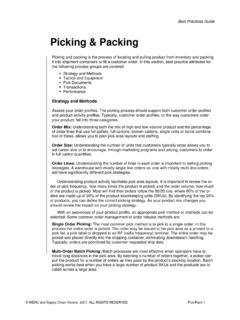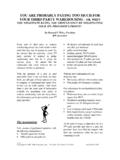Transcription of Introduction to Warehousing & Fulfillment Process ...
1 Process Benchmark & Best Practices Guide Warehousing & FulfillmentAbout the Authors Supply Chain Visions, is a small specialized consulting firm focused on helping companies with Supply Chain strategy and education. ARC Advisory Group recently recognized Supply Chain Visions as one of the 10 coolest boutique consulting firms for their results-driven approach which reflects solutions that are strategic as well as practical, cost effective and focused on driving measurable performance improvements. Supply Chain Visions has been a key contributor to WERC s knowledge base in the area of benchmarking and distribution performance metrics, having developed (and teaching) both the Warehouse Metrics and Benchmark Now!
2 Seminars. Supply Chain Visions is also the co-researcher in WERC s Annual Warehouse Benchmarking Study. The four thought leaders from Supply Chain Visions contributed to this publication. Among them they have authored over 75 articles, visited over 350 facilities, given over 100 presentations and taught classes at over 20 different universities. Kate Vitasek, founder and managing partner of Supply Chain Visions, is a well-recognized authority on performance management, benchmarking and metrics implementation for warehouses and DCs. She has been recognized for her leadership in the profession as a Woman on the Move in Trade and Transportation by the Journal of Commerce and was also recognized a as a Rainmaker by DC Velocity Magazine.
3 She is also on the faculty for both University of Tennessee s Center for Executive Education and Wright State University. She is a frequent speaker and contributor for WERC. She has also served on the Board of Directors for the CSCMP. Kate received her MBA from the University of Tennessee in Logistics. Cheryl Harrity, principal. Prior to joining Supply Chain Visions, Cheryl was the Supply Chain Practice Lead for APQC (American Productivity and Quality Center) where she developed APQC s supply chain benchmarking program and led the WERC consortium study, Reverse Logistics: Backward Practices That Matter. Cheryl has 17 years of strong operational experience over a diverse range of industries.
4 She is a result-driven professional with a proven track record in building and strengthening distribution operations business platforms. She has lead Fortune 500 firms with projects such as developing standard operating procedures, planning WMS implementation and developing processes and practices to build the requirements for Transportation Management Systems. Cheryl holds a Master of Business Administration in Physical Distribution from Temple University. Kimberly O Donoghue, principal. Her background includes broad experience in distribution operations, account management, finance and international market-entry planning in both the United States and Asia. As a practitioner, Kimberly actively led key operational roles at Donnelley and Sons / Modus Media International.
5 She went on to hold a variety of senior positions in sales management, strategic sales planning and large account management. Kimberly is a thought leader in goals and objectives alignment and tying the right measures to strategic objectives. She teaches WERC s Warehouse Metrics seminar. She also speaks and writes Chinese. Kimberly earned an MBA in Finance from the American Graduate School of International Management. Steven Symmes, principal, has operational and consulting experience in start-up and high growth companies that span the retail, high technology, industrial equipment, medical equipment, software publishing, computer manufacturing, consumer electronics, third party logistics and distribution sectors.
6 He has worked extensively throughout the United States, and in Europe, Asia and Latin America. Prior to Supply Chain Visions, Steve held senior positions in operations, supply chain management and sales/marketing organizations including Managing Director, Director of New Business Operations, Director of Global Operations and Strategic Accounts and Global Director of Supply Chain Solutions. Steve graduated from the University of Colorado with an MBA in Production and Operations Management The Warehousing Education and Research Council sponsors this publication as an informational resource. The text does not express the policy, have the endorsement or reflect the recommendations of WERC.
7 ISBN 1-892663-39-2 Process Benchmark & Best Practices The Warehousing Education and Research Council (WERC) has compiled The Warehousing and Fulfillment Process Benchmark & Best Practices Guide as a workbook for warehouse practitioners to learn more about Warehousing best practices. The workbook outlines processes that are typically found in warehouse operations and allows warehouse practitioners to identify Process strengths and weaknesses in their organization. They can then craft a roadmap for improvement efforts. This workbook complements CSCMP s Supply Chain Management Process Standards by expanding section Warehousing and Fulfillment . It also serves as a companion workbook to the Benchmarking Guide published by WERC.
8 The workbook outlines eight topics that will help warehouse practitioners understand current warehouse performance as well as gain a solid understanding of best practices for key processes. The topics are: 1. Receiving & Inspection 2. Material Handling & Putaway 3. Slotting 4. Storage and Inventory Control 5. Picking & Packing 6. Load Consolidation & Shipping 7. Shipment Documentation 8. Warehouse Management System (WMS) Each topic includes: Process Benchmark Descriptions Explanations of the processes, practical examples and definitions. Benchmarks. Lists the Process groups that support the major warehouse activities and outlines attributes in five ranking columns: Poor Practice, Inadequate Practice, Common Practice, Good Practice, and Best Practice.
9 Self Assessment Table and Ranking Ranges Table are templates to self-evaluate and rank each Process group. Key Performance Metrics from a recent WERC Benchmark Study. A case study illustrating best practices. NOTE: Each industry is unique and the metrics provided here are from a number of industries and are good for general comparisons. Companies are encouraged to seek out additional benchmark data from the WERC Annual Benchmarking Survey, which includes benchmark detail for a number of specific industries. The complete benchmarking survey results are available to WERC members at ISBN 1-892663-39-2 Copyright 2007, WERC and Supply Chain Visions. All rights reserved. Intro 1 Warehousing and Fulfillment Using the Workbook STEP 1.
10 Review the Process Benchmarks Self-assessment begins with a comparison of your company s processes against the ranked Process attributes in the Process Benchmarks table. Receiving & Inspection: Process Benchmarks Process Group Poor Practice Inadequate Practice Common Practice Good Practice Best Practice Dock Management Transactions Attributes STEP 2. Fill Out the Self-Assessment As you review the attributes for each Process group, you can determine in which category your Process falls: Poor Practice, Inadequate Practice, Common Practice, Good Practice, or Best Practice. These rankings are assigned a numeric value from 1 to 5. Receiving & Inspection: Key Performance Metrics (KPI)
